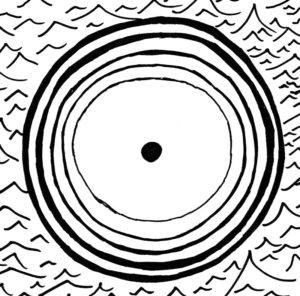We’re trying to find the frequency at which a gear on a fidget toy is spinning. Firstly, the centres of each gear form a hexagon shape. Since each gear has radius 10 centimetres, this hexagon has side length 20 cm. In a hexagon, the distance between two opposite vertices is double that of the side length. So the outermost gear is 40 cm from the innermost. Centripetal force is π2rλ/s inwards. r is the distance between the point that’s moving and the point it’s moving around. λ is the frequency at which it is moving around. We can move around the elements around to see that λ = Fs/π2r, where F is centripetal force. Plug in the knowns to see that the gear is moving around 0.2533 times per second. If you tried making the device, you’d see that only three gears spin. That’s because, for the anchored gear to stay in position, the motion of the hexagon has to exactly balance it’s rotation. That means 2 other gears will be balanced, but the other 3 will move at double speed. Half from the rotation of the hexagon and half from their own rotation. So the rotation from the hexagon, 0.2533 rotations equals that at which the gear is spinning. Therefore the gear is moving at 0.2533 rotations per second.
Day: October 6, 2019
Solution to Gangbuster Geometry

We’re trying to find the amount of time it takes for a ball to resurface after hitting water. The simplest way to do this is to make a simulation of all the forces acting on the ball. The buoyant forces, given by the second equation require you to calculate the amount of water the ball has displaced, so you must calculate the volume of a sphere cap. The volume of a sphere cap is given by the fourth equation. The third equation, for drag, requires the frontal area of the sphere cap, which is given by the fifth equation. We put these together to get a simulation. The answer is the time in between a peak and a trough. This time actually fluctuates a bit. Our answer is that the average frequency is about one ripple every 0.3969 seconds.
\vec F_G=1kg g\ down\\[8pt] \vec F_B=\frac{998.2kg gV_w}{m^3}\ up\\[8pt] \vec F_d=\frac{469.2kgA_f\vec V^2}{m^3}\ up\\[16pt] V_w=\pi rh^2-\frac{\pi h^3}3\\[8pt] A_f={\pi r^2\over(r-d)^2}-\pi